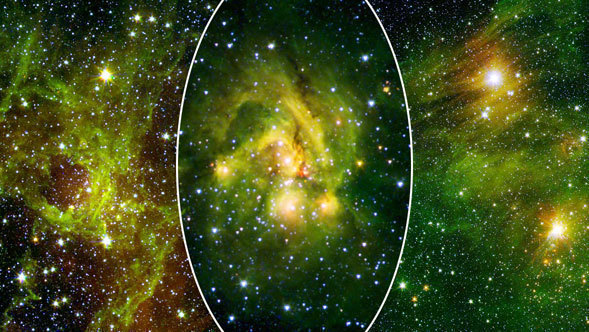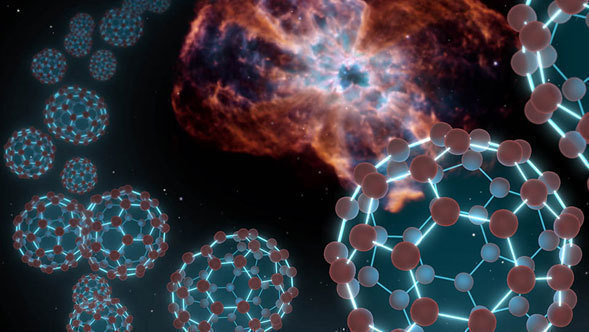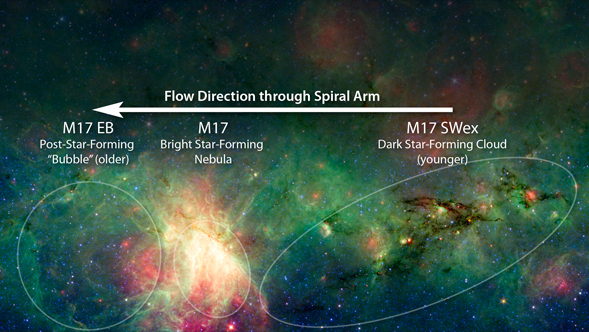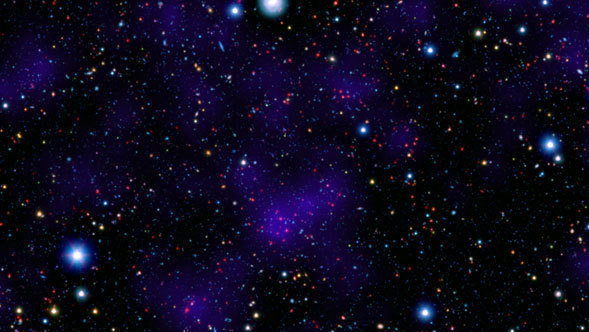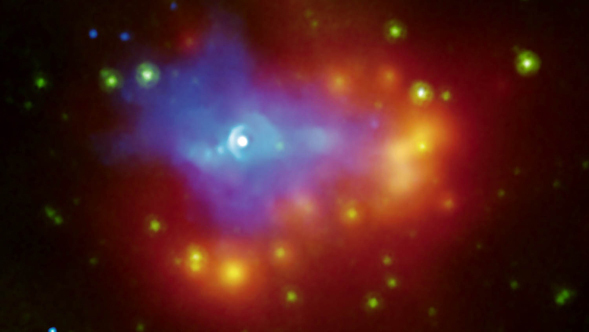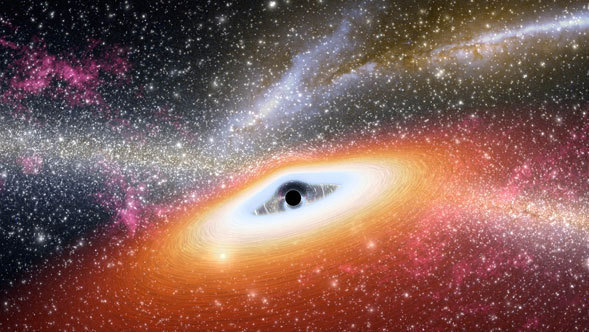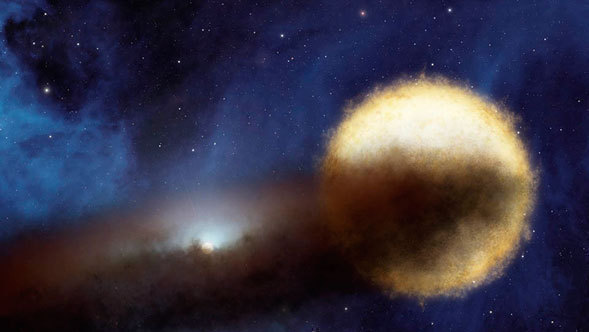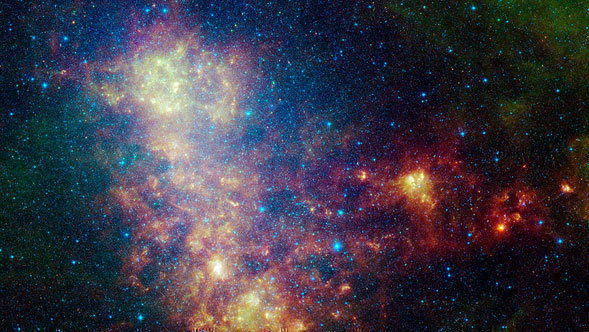Displaying news 271 - 300 of 587 in total
Popular Science Magazine
A new image of two tangled galaxies has been released by NASA's Great Observatories.
A new survey by NASA's Spitzer Space Telescope has turned up treasures aplenty in the outer regions of the Milky Way, where amidst fogs of interstellar chemicals some rare, young and enormous stars are blasting gas out into space.
Astronomers using NASA's Spitzer Space Telescope have discovered carbon molecules, known as "buckyballs," in space for the first time. Buckyballs are soccer-ball-shaped molecules that were first observed in a laboratory 25 years ago.
Astronomers caught their first glimpse of a dusty disk closely encircling a massive baby star, providing direct evidence that massive stars form in the same way as their smaller counterparts.
New observations of a dust cloud trailing Earth may help astronomers find Earth-like planets around distant stars. NASA's Spitzer Space Telescope mapped the structure of this dust and measured how it interacts with our own planet.
NASA's Spitzer Space Telescope has revealed a cosmic cloud shaped like a flying dragon that has a secret burning behind its dark scales.
Astronomers have uncovered what appear to be 14 of the coldest stars known in our universe. These failed stars, called brown dwarfs, are so cold and faint that they'd be impossible to see with current visible-light telescopes, but Spitzer's infrared vision was able to pick out their feeble glow.
Our sun may be an only child, but most of the stars in the galaxy are actually twins. The sibling stars circle around each other at varying distances, bound by the hands of gravity.
Astronomers are a bit like archeologists as they dig back through space and time searching for remnants of the early universe. In a recent deep excavation, courtesy of NASA's Spitzer Space Telescope, astronomers have unearthed what may be the most distant, primitive cluster of galaxies ever found.
NASA's Spitzer Space Telescope has discovered something odd about a distant planet -- it lacks methane, an ingredient common to many of the planets in our solar system.
Astronomers have their eyes on a hot group of young stars, watching their every move like the paparazzi. A new infrared image from NASA's Spitzer Space Telescope shows the bustling star-making colony of the Orion nebula, situated in the hunter's sword of the famous constellation.
A new image from NASA's Chandra and Spitzer space telescopes shows the dusty remains of a collapsed star. The dust is flying past and engulfing a nearby family of stars.
NASA's Spitzer Space Telescope team has been selected to receive the 2010 Maria and Eric Muhlmann Award from the Astronomical Society of the Pacific.
Astronomers have come across what appear to be two of the earliest and most primitive supermassive black holes known. The discovery, based largely on observations from NASA's Spitzer Space Telescope, will provide a better understanding of the roots of our universe, and how the very first black holes, galaxies and stars came to be.
Astronomers have used NASA's Spitzer Space Telescope rather like a doctor's stethoscope to listen in on the "heartbeat" of star formation in our galaxy, a finding that will help trace the "life" of the Milky Way and other galaxies.
Imagine finding a living dinosaur in your backyard. Astronomers have found the astronomical equivalent of prehistoric life in our intergalactic backyard: a group of small, ancient galaxies that has waited 10 billion years to come together. These "late bloomers" are on their way to building a large elliptical galaxy.
New findings from NASA's Chandra X-ray Observatory have provided a major advance in understanding a type of supernova critical for studying the dark energy that astronomers think pervades the universe. The results show mergers of two dense stellar remnants are the likely cause of many of the supernovae that have been used to measure the accelerated expansion of the universe.
Artwork inspired by NASA's Spitzer Space Telescope is making an appearance at this year's Winter Olympics in Vancouver, British Columbia.
Harvard-Smithsonian Center for Astrophysics
For almost two centuries, humans have looked up at a bright star called Epsilon Aurigae and watched with their own eyes as it seemed to disappear into the night sky, slowly fading before coming back to life again.
Carnegie Institution of Washington
NASA's Spitzer Space Telescope has captured an action-packed picture of the nearby Small Magellanic Cloud, a small galaxy that looks like a wispy cloud when seen from Earth.
This composite graphic encompasses a quarter century of infrared astronomy from space, a world away from Galileo Galilei's eight-power telescope that was the cutting edge of astronomy 400 years ago. It also illustrates some of the contributions from the Infrared Processing and Analysis Center (IPAC) to this progress by way of astronomical data processing, analysis, archiving and dissemination.
In an unveiling of truly galactic proportions, the world's largest image of our Milky Way galaxy, taken by NASA's Spitzer Space Telescope, will be unveiled at the Adler Planetarium in Chicago.
NASA's Spitzer Space Telescope has contributed to the discovery of the youngest brown dwarf ever observed -- a finding that, if confirmed, may solve an astronomical mystery about how these cosmic misfits are formed.
The Chandra X-ray Observatory Center
Before our planets found their way to the stable orbits they circle in today, they wiggled and jostled about like unsettled children.
On Friday, Oct. 23, engineers with NASA's Spitzer Space Telescope successfully swapped the spacecraft from the main nitrogen thruster string to a backup thruster string.
Four hundred years ago when Galileo turned his tiny telescope to the night sky our view of the Universe changed forever. Since that historic moment, we have continued to gain an appreciation for the vastness of space, while struggling to find our place in it. We ask: Where did we come from? Are we alone? Exploring these questions, NASA's Spitzer Space Telescope Science Center is participating in the Pasadena Art & Ideas festival "Origins" with an exhibit titled: "Origins in the Universe". The festival runs October 23 - November 9, 2009 in venues across Pasadena, Calif.
Displaying news 271 - 300 of 587 in total


